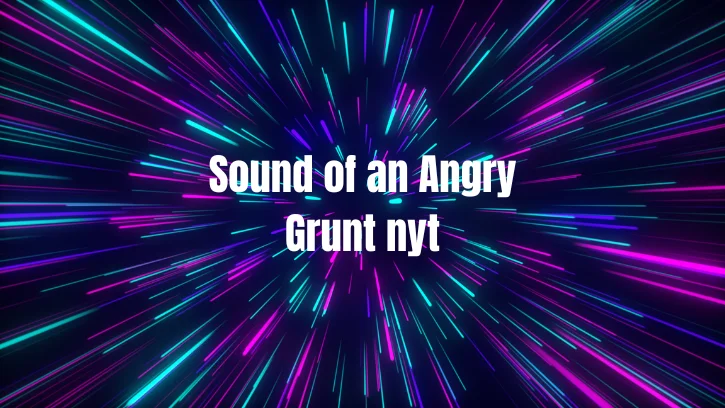The term “angry grunt” often conjures images of frustration, power, and raw emotion. It’s a sound that, although simple, carries a myriad of meanings and connotations. In this article, we will delve into the nature of the “angry grunt,” exploring its origins, significance, and representation in various contexts, including its mention in the New York Times.
The Nature of an Angry Grunt
Overview of the Sound
An angry grunt is typically characterized by a low, guttural sound that emanates from deep within the throat. It is a non-verbal vocalization used by humans and animals alike to express displeasure, frustration, or aggression. The sound varies in intensity and duration, often reflecting the level of anger or frustration experienced by the individual.
Origins and Evolution
The grunt has roots deep in human evolution, dating back to our primate ancestors. In early human societies, non-verbal sounds like grunts played a crucial role in communication, especially in situations where verbal communication was not feasible. The angry grunt, in particular, may have been used to convey warnings, assert dominance, or signal distress.
Cultural Significance
Across cultures, the angry grunt has maintained its presence as a powerful, if primitive, form of expression. In literature, film, and everyday life, it serves as an immediate and visceral indicator of a character’s emotional state. The sound cuts through pretense and taps into a universal understanding of anger and frustration.
The Angry Grunt in Modern Media
Representation in Literature and Film
In modern storytelling, the angry grunt is often used to add depth to characters. It can signify a breaking point, a moment of intense emotion that words cannot adequately convey. For example, in action films, a hero’s angry grunt during a climactic battle scene can heighten the sense of urgency and raw power.
The New York Times Mention
The phrase “sound of an angry grunt nyt” has been used in various articles and reports, including those by the New York Times. Such mentions often appear in pieces discussing sports, politics, or social issues, where the sound metaphorically represents intense disagreement or conflict. For instance, an article about a heated political debate might describe a politician’s response to an opponent’s comment as an “angry grunt,” capturing the raw emotion of the moment.
Psychological and Physiological Aspects
Why Do We Grunt?
From a psychological standpoint, the angry grunt serves as an emotional outlet. When words fail, a grunt can effectively convey what we are feeling. This is particularly true in moments of intense frustration or anger, where the brain’s fight-or-flight response is activated, and more primal forms of communication take over.
Physiological Responses
When a person emits an angry grunt, several physiological changes occur. The body’s stress response is triggered, leading to an increase in heart rate, adrenaline production, and muscle tension. These changes prepare the body for potential confrontation or action, reflecting the primal roots of this vocalization.
The Angry Grunt in Sports
Athletic Performance and Emotion
In the realm of sports, the angry grunt is a common sound. Athletes, particularly in high-intensity sports like tennis or weightlifting, often grunt as a way to release tension and focus their energy. This sound can also serve to intimidate opponents, asserting dominance and psychological superiority.
Case Studies
Notable examples include tennis players like Rafael Nadal, whose grunts during matches are almost as famous as his skill on the court. These grunts are not merely expressions of effort but also strategic tools to maintain rhythm and mental focus.
Social and Interpersonal Dynamics
Grunts in Everyday Life
In everyday interactions, the angry grunt can be a powerful communicative tool. Whether in a heated argument, a moment of frustration at work, or a stressful situation at home, this sound conveys feelings that might be difficult to articulate otherwise. It serves as an immediate, albeit primitive, form of emotional expression.
Impact on Relationships
While an angry grunt can effectively communicate frustration, it can also impact relationships. Frequent use of such non-verbal expressions can lead to misunderstandings and conflicts if not addressed constructively. Understanding the underlying emotions and addressing the root causes of frustration is crucial in maintaining healthy communication.
Conclusion
The sound of an angry grunt nyt is a fascinating and complex aspect of human expression. From its evolutionary origins to its role in modern media and everyday life, this simple sound carries profound meaning. It reflects our most primal instincts and serves as a powerful tool for emotional communication. As we continue to explore the nuances of human expression, the angry grunt remains a compelling subject, offering insights into the depths of human emotion and interaction.
FAQs
- What is an angry grunt?
- An angry grunt is a low, guttural sound made from deep within the throat, often used to express frustration, anger, or aggression.
- Why do people grunt when they are angry?
- Grunting when angry serves as an emotional outlet and a form of non-verbal communication, often occurring when words fail to adequately express intense emotions.
- Is the angry grunt common in animals?
- Yes, many animals use similar vocalizations to express anger, assert dominance, or communicate distress, reflecting the evolutionary roots of this sound.
- How is the angry grunt used in sports?
- In sports, athletes grunt to release tension, focus their energy, and sometimes intimidate opponents, as seen in high-intensity sports like tennis and weightlifting.
- Can frequent grunting impact relationships?
- Yes, frequent use of grunts can lead to misunderstandings and conflicts in relationships. Addressing the root causes of frustration and improving communication is essential for maintaining healthy interactions.



